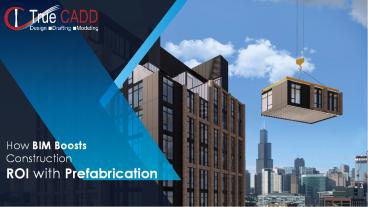How BIM Boost Construction ROI with Prefabrication - PowerPoint PPT Presentation
Title:
How BIM Boost Construction ROI with Prefabrication
Description:
Building components manufactured offsite and in controlled environments show higher levels of quality backed by low material waste. Improved productivity, better quality, enhanced cost certainties, upgraded safety, etc. are some of the benefits that prefabrication and modular construction deliver. The following presentation draws attention to the benefits of prefabrication to improve construction ROI for AEC stakeholders. – PowerPoint PPT presentation
Number of Views:104
Title: How BIM Boost Construction ROI with Prefabrication
1
How BIM Boosts Construction
ROI with Prefabrication
2
Based on a study by Dodge Data and
Analytics, 2020 BIM - based prefabrication
improves ROI by
89
90
87
Improving productivity
Improving quality
Improving schedule certainty
81
81
Improving cost predictability
Reducing construction waste
3
Challenges faced by constructionprofessionals
with conventional methods of construction
- Lack of coordination
- Lack of sequence
- Lack of clarity of roles
- Site disturbances
- Greater material waste
- Time and labor wastage
- Delayed schedules
- Unsafe construction
- Higher costs
- Contractors, architects, site engineers
- MEP contractors
- Prefabrication firms
- Construction companies
4
- Projects can be completed 35 to 55 quicker with
BIM-based prefabricated and modular construction.
5
- Prefabrication drives greater construction ROI
with integrated BIM
5 ways
6
1
Minimized construction waste saves cost
the challenge
- Greater material waste with traditional
construction - Fabrication errors with inaccurate and incomplete
2D drawings
the solution
- Accurate 3D model-based shop drawings reduce
manufacturing waste and reduce rework - Advanced tools integrated with BIM enable
contractors to visualize project scope, material
costs, etc. - The elements with typical size can be filtered
with BIM model to help overall savings of cost
7
2
Better quality control
the challenge
- Components manufactured onsite may be of
low-quality due to incorrect usage or damage - Weather conditions deteriorate the material
quality reducing construction quality - Exposed project sites can lead to material theft
the solution
- Manufacturing components in an offsite controlled
environment drives high-quality with LOD 400 BIM
models - Large batches of replicated products with 21 days
curing and controlled temperature, moisture,
wind, atmospheric pressure improve productivity - Offsite prefabrication factories are secure,
cancelling out material thieving
8
Minimum site disruption
3
the challenge
- Onsite fabrication of building materials can
disrupt traffic around the project site - Use of heavy machinery and frequent material
movements produce plenty of noise - Storing material onsite requires additional space
which is very rare
the solution
- Offsite prefabrication cancels out site
disruption through seamless logistics - Minimal use of machinery, materials, and labor
cancels out site noise - BIM-based models have unique numbers assigned to
components for easier onsite assembly and
installation
9
Better construction schedules reduce delays
4
the challenge
- Flawed quantity takeoffs with inaccurate
CAD-based drawings - Inaccurate fabrication and installation schedules
- Coordination issues and inaccurate material
logistics
the solution
- Prefabricated components take less time to build
- BIM based scheduling is accurate as compared to
traditional construction and diminishes schedule
delays - BIM enabled fabrication and installation is quick
and reduces project costs
10
Flexibility, reusability, and safety with reduced
onsite risks
5
the challenge
- Traditional fabricated components are not
flexible and reusable - Limited design opportunities do not work with
external aesthetics - Onsite construction teams face greater risks of
accidental hazards with onsite fabrication
the solution
- Prefabricated or modular components are better
engineered for flexibility, reuse, and
performance - Multiple design prototypes using BIM can
integrate prefabricated units to match the
aesthetics of buildings - Offsite prefabrication lowers onsite risks caused
by accidents and liabilities
11
77 of contractors believe BIM will enable
prefabrication for complex and large projects
Dont stay behind.
- Contact us now!
www.truecadd.com info_at_truecadd.com































